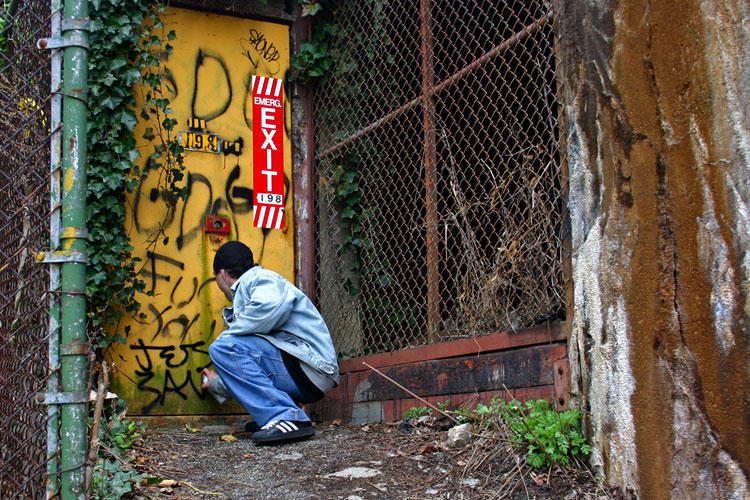Vandalism / Graffiti
Penal Code Section 594 States:
“(a) Every person who maliciously commits any of the following acts with respect to any real or personal property not his or her own, in cases other than those specified by state law, is guilty of vandalism:
(1) Defaces with graffiti or other inscribed material.
(2) Damages.
(3) Destroys.
Whenever a person violates this subdivision with respect to real property, vehicles, signs, fixtures, furnishings, or property belonging to any public entity, as defined by Section 811.2 of the Government Code, or the federal government, it shall be a permissive inference that the person neither owned the property nor had the permission of the owner to deface, damage, or destroy the property.
(b) (1) If the amount of defacement, damage, or destruction is four hundred dollars ($400) or more, vandalism is punishable by imprisonment in the state prison or in a county jail not exceeding one year, or by a fine of not more than ten thousand dollars ($10,000), or if the amount of defacement, damage, or destruction is ten thousand dollars ($10,000) or more, by a fine of not more than fifty thousand dollars ($50,000), or by both that fine and imprisonment.”
Vandalism is the malicious damage of someone else’s property. The crime of graffiti “tagging” is prosecuted as Vandalism.
Vandalism can be either a misdemeanor or felony. Whether to charge the accused with a misdemeanor of felony is determined by the amount of money required to ‘repair’ the damage caused. If the amount exceeds $400.00., then it is likely the accused will be charged with a felony.
Examples of Acts Constituting Vandalism
- Slashing a tire
- Breaking a window
- Damaging a bench
- Ripping a bus seat
- Toppling a headstone
- Etching a window
- Removing an emblem off a car
- Carving initials into a desk
- Putting graffiti (with spray paint or permanent marker) on a school wall
Keep in mind that ‘graffiti’ vandalism is often viewed by prosecutors as a ‘gateway’ offense, meaning that law enforcement considers graffiti art and gang activity to go hand in hand. Consequently, a conviction of graffiti vandalism is likely to ‘red flag’ the accused as a potential gang member.
VANDALISM: What the Prosecutor MUST Prove Beyond a Reasonable Doubt
Jury Instruction 2900. Vandalism
The defendant is charged [in Count ] with vandalism [in violation of Penal Code section 594].
To prove that the defendant is guilty of this crime, the People must prove that:
1. The defendant maliciously (defaced with graffiti or with other inscribed material[,]/ [or] damaged[,]/ [or] destroyed) (real/ [or] personal) property;
[AND]
2. The defendant (did not own the property/owned the property with someone else)
<See Bench Notes regarding when to give element 3.>
[AND]
3. The amount of damage caused by the vandalism was $400 or more.]
Someone acts maliciously when he or she intentionally does a wrongful act or when he or she acts with the unlawful intent to annoy or injure someone else.
Graffiti or other inscribed material includes an unauthorized inscription, word, figure, mark, or design that is written, marked, etched, scratched, drawn, or painted on real or personal property.
Vandalism is not limited to common property damage crimes. Additional crimes prosecuted under the California Vandalism Laws include:
- Possession of aerosol containers of paint under 18 (Penal Code 594.1)
- Possession of vandalism tools (Penal Code 594.2)
- Vandalism to a church or synagogue (Penal Code 594.3)
- Vandalism to government facilities or vehicles (Penal Code 640.5)
- Vandalism on or near a highway (Penal Code 640.7)
- Vandalism on a freeway (Penal Code 640.8)
- Vandalism using noxious or caustic chemicals (Penal Code 594.4)
In California, particularly Los Angeles, Ventura, and Orange counties, vandals are prosecuted to the fullest extent of the law as part of a general vandalism prevention initiative. Strong legal representation is critically important for anyone who is accused of vandalism, especially when charged with a felony. A skilled legal representation may improve your chances of dismissal or to secure a reduction in charges at the pre-filing, or early stage of the proceedings.
If you are not a United States citizen, your immigration status or application for citizenship may be in jeopardy if convicted of felony Vandalism.
If you or someone you know has been charged with Vandalism, contact John J. Stanley & Associates at (818) 769-5200 for your free consultation.

